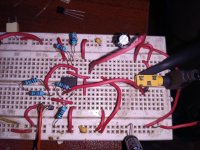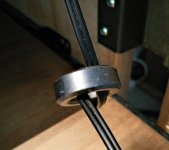Or some floucent lamps with big ballasts near amp ?noisy?
switching supply nearby ?
They can be really nasty and difficult to find if you are not aware that they radiate hum.
Try turn the ?230 volt down to trace the reason for the ?hum.
Some pictures would sure help to find the culprit.
Last edited:
...Some pictures would sure help to find the culprit.
Pictures are linked in post #3.
I have NO idea why they are hosted on an annoying site, when they can easily be hosted here:
Attachments
The amplifier was powered with batteries, so the chances of noise getting in would be low. Maybe it's coupling in from my oscilloscope which I think does have a switching power supply (1054Z) but it was quite far away. I also use LED lights, so CFLs aren't causing issues. I do have a UPS powering everything, but even so, the amplifier itself is powered by batteries.
As for why the photos are hosted on another site - the phone site was wonky and wasn't working well enough, so I used mega as I already use it for quite a few things.
As for why the photos are hosted on another site - the phone site was wonky and wasn't working well enough, so I used mega as I already use it for quite a few things.
The amplifier was powered with batteries, so the chances of noise getting in would be low. Maybe it's coupling in from my oscilloscope which I think does have a switching power supply (1054Z) but it was quite far away. I also use LED lights, so CFLs aren't causing issues. I do have a UPS powering everything, but even so, the amplifier itself is powered by batteries.
As for why the photos are hosted on another site - the phone site was wonky and wasn't working well enough, so I used mega as I already use it for quite a few things.
You should not suppose or beleive anything in this connection.
Knowing is the point here
So:
1.
Mount some headphones on amp (supplied by batteries), is it noisy/humming ?
2-
If yes disconnect all things connected to mains, turn off build in lamps etc. that is permanently mounted.
3.
Turn off the group breakers.
4.
Turn off the main breaker switch for the mains.
Go check if noise is still there.
5. if the noise is still there you have eliminated influence from the mains (your part of the net not the neighbors if you live in a multi floor property) and can go find the source in the construction (beware you have normally a relatively high output Impedance/resistance from the PSU when you use batteries as a power source).
6.
If the noise disappered (i bet it did) then turn on the main breaker, check if noise back.
7.
and then the group breakers, check if noise back when turning on breaker for EVERY one of them.
8.
Then all the other stuff one by one check EVERY time in phones for noise.
9.
You found the culprit and now go fix the problem
10.
You learned something new in the process i hope
Last edited:
You need the like 1 micro farad foil condensor between + and - powersupply pins directly mounted (soldered) on top of the operational AMP (IC).Pictures are linked in post #3.
I have NO idea why they are hosted on an annoying site, when they can easily be hosted here:
Take it out of the breadboard and solder the it directly to the PSU pins.
Take care that you do not use exess solder so you can mount the IC again in the bread board.
And clean the da.. thing up for dust and sh..
And you could have a defective IC has happened for med cause of not using ESD precaution procedures
And for inspiration:
Avoiding Op-Amp Instability Problems In Single-Supply Applications | Analog Devices
Hope you get it working now.
Last edited:
@Snaffe I doubt it's what you're saying. I've built a discrete transistor headphone amp too, and it didn't pick up anything, and the input impedance was higher than the op amp (I had 1K pull downs on the op amp inputs). Chances are - my op amps are probably fakes since I did buy them from China - I know shame on me, but digikey costs too much in shipping where I live and the local stores buy from China too so no luck there. Thanks for your help though. Much appreciated man.
another solution
Today I had the exact same problem: noise in one channel that sounded like EMI.
A resistor in series with the output was not necessary.
I solved the problem with one loop of the headphone cable through a ferrite ring that I salvaged from an old pc power supply.
Today I had the exact same problem: noise in one channel that sounded like EMI.
A resistor in series with the output was not necessary.
I solved the problem with one loop of the headphone cable through a ferrite ring that I salvaged from an old pc power supply.
Attachments
- Status
- This old topic is closed. If you want to reopen this topic, contact a moderator using the "Report Post" button.
- Home
- Amplifiers
- Headphone Systems
- My "headphone amp" is very noisy. How do I fix it?

